by California Casualty | Educators |
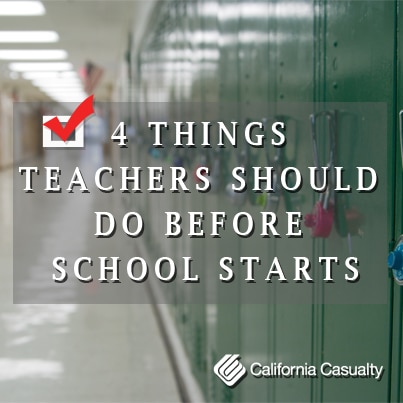
For many teachers, the beginning of the school year is both exciting and overwhelming. In the final few weeks of summer, their minds are racing with thoughts of lesson plans, class rosters, assessments, Back-To-School Night, and classroom set up. Before you dive into your classroom theme or your new reading corner, consider the following items as you prepare the upcoming school year:
1. Tackle Your Personal “To Do” List
Seemingly small tasks can become a burden during the hectic school year. Do yourself, and your family, a favor by taking care of these things before you head back to school. Get household affairs in order: make doctor/vet appointments for all members of the family, finish incomplete summer projects, and tackle any needed car or home maintenance. It would also be a good time to evaluate your personal finances – including your auto and home insurance. Check out the “Get a Quote” box to the right. You might be able to save some serious money!
Fewer items on your personal/family “To Do” list means more time to grade papers and plan lessons, right?
2. Plan Ahead for Professional Development
Once the school year has started, it may be difficult to switch from thinking about lesson plans, to thinking about your professional development. Many districts lack the funds to provide quality professional development opportunities to teachers. If this is true for you, check out the continuing education courses at your local university. Before the school year begins, enroll in coursework that will benefit you in your professional development. Some school districts may even have a tuition reimbursement program.
3. Re-establish Routines
Make it a point to re-introduce daily routines before the school year begins. Many of us get used to a more relaxed routine during the summer months: bedtimes are later, mornings are less hurried, and brains take a break.
A week or two before school begins, introduce your usual routine. You can start slowly, or all at once. Create (and stick to) bedtimes, set morning alarm clocks, practice bathroom routines, and eat a healthy breakfast. Don’t forget to incorporate some reading time into that routine! Having a routine in place before heading back to school, for both teachers and students, helps ease the transition from summer to the school year.
4. Take a Moment for Yourself
Take a day, a half-day, or even just an hour, before you head back to school for some “me” time. Lounge by the pool, give yourself a pedicure, get a haircut, watch a movie, or even have a spa day. Whatever your choice of leisure activity, squeeze in some time for yourself before diving into the new school year.
Cheers to a great new school year!
Erin Randolph has taught elementary school in Louisburg, Kansas for eight years. She lives in Olathe, KS with her husband, a three-year-old son, and a two-year-old daughter (and a seven-year-old border collie).
by California Casualty | Educators |

Pictured here from left to right are: Susan Frantz (Group Marketing Team Manager, California Casualty), Tom Torlakson (CA Superintendent), Beau Brown (CEO, California Casualty) and Lisa Almeida (Assistant Vice President Group Marketing, California Casualty)
The Association of California School Administrators and California Casualty are mutually committed to serving members who lead great schools. California Casualty is proud to stand with ACSA for more than 30 years as it supports the administrators who encourage and steer their staff to attain new heights in an ever changing education environment. ACSA lends support to its members through professional development, sharing of great ideas and innovation and with benefits of membership.
As the Presenting Sponsor of the California Department of Education’s School Recognition Program, California Casualty has recommitted to ACSA’s goal of supporting California’s educators and administrators, helping make possible events that honored the 2015 Teachers of the Year, Classified School Employees of the Year, and the 373 secondary schools named 2015 Gold Ribbon Schools.
California Casualty CEO Beau Brown remarked what a privilege it was to play a key role in acknowledging the achievements and successes of California educators and their schools. “Our partnership with the California Department of Education is a testament of how schools, businesses and communities can come together to promote the remarkable successes of those developing the minds of our future generations.”
ACSA and California Casualty salute the great work of administrators across the Golden State and the schools they lead. Together, our organizations are able to do more for the ACSA members we serve. A California Casualty representative would welcome the opportunity to explain the many benefits that come with ACSA membership. If you would like more information, contact Roxanne Dean, 1.800.964.3903 ext. 5923 or [email protected].
by California Casualty | Educators |
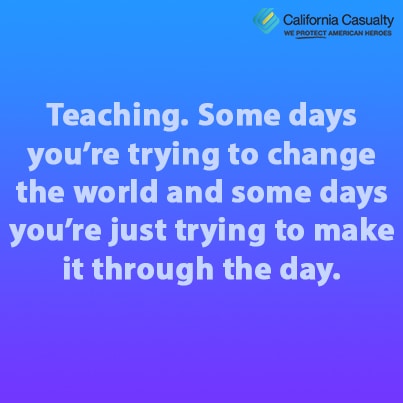

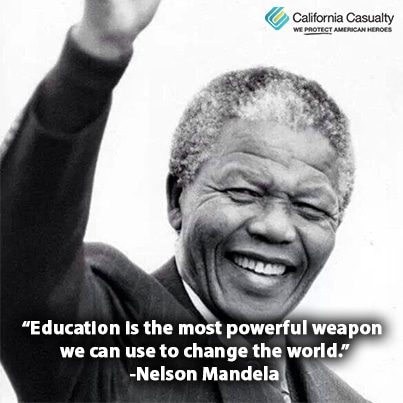
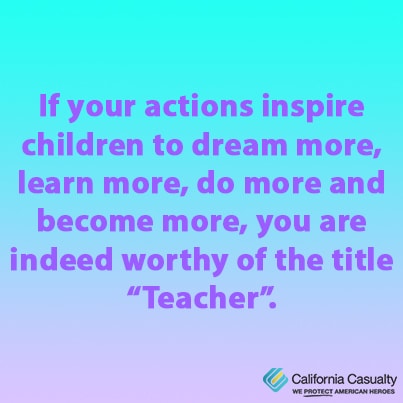

Check out these quotes for other occupations:
First Responders
Nurses
by California Casualty | Educators |
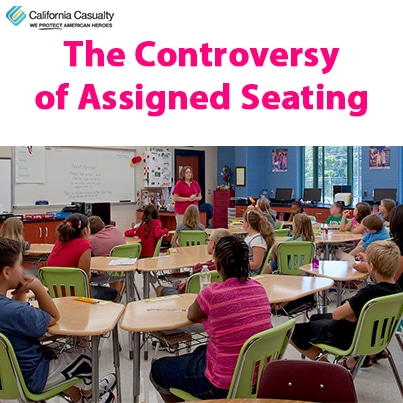 by Thomas Brown
by Thomas Brown
Next year I’ll be going into my sophomore year of high school. Throughout my eleven years of school I’ve had teachers who let us sit with our friends, teachers who assign seating, teachers who have couches for us to sit on, teachers who let us sit on the floor and even teachers who make us sit on the floor (this happened twice; in kindergarten and 8th grade). I’ve had classrooms that were so quiet it was borderline awkward, and then I’ve been in those classes that are so loud other teachers have to come in and tell us to be quiet. You could say I’ve seen it all.
Personally, I’ve always liked free-seating. In my experience, sitting next to my friends, especially at the beginning of the year when I don’t know everyone in my class, puts me at ease and helps me participate more in class. Also, I’ve noticed that the kids who usually are the loudest in the class will talk to anyone sitting near them, friend or not.
The way I see it, if I have to have someone talk my ear off for an hour, I’d rather it were my friend saying something interesting than just another loud classmate. Additionally, I’ve found that friends will find a way to communicate with each other in class even if they are sitting far apart. Once again this is just my opinion, but someone whispering quietly to the person next to them is pretty much always less distracting than someone yelling, waving their arms, and making weird faces to get someone’s attention from across the room.
Despite being against assigned seating, I do admit there are some good arguments for seating charts and teachers choosing the seating. As I said before, I’ve been in many a class that is out of control and often a seating chart can help calm if not completely get rid of distractions. However, these are extreme cases and I feel like the best approach might be what many of my teachers tend to use, which is to reward quieter, on-task classes with free seating and force distracted classes to sit separately from their friends.
Whether or not to have assigned seating should depend on the behavior of the class, giving the students a reason to stay on task. Ultimately, however, it is the teacher’s choice on whether or not a class should have assigned seats. But if you happen to be on the fence about it, my advice would be to let the students choose where they sit.
by California Casualty | Educators |

Donn Harrison doesn’t think of himself as exceptional. He’s a kindergarten teacher at Parkview Elementary School in Cameron, Missouri, where he also volunteers as a firefighter and ambulance driver/ EMT. He says he is just a regular guy who loves his family and his community.
But, millions of Americans think he is much more than that. They voted in droves, helping him win Live! with Kelly and Michael’s Top Teacher of 2015 contest. Donn won new laptop computers for his school, a new car, $20,000 and a Caribbean vacation.
What makes Donn such an amazing teacher and member of his community? California Casualty recently had the privilege of talking with Donn to learn more.
First, Donn said he is humbled by the attention and the prize. “My wife nominated me thinking I might get a mention and a thank you note,” he said. “Then, I got word I was one of 12 finalists. What an honor; it blew my mind to think that I was thought of as one of the 12 best teachers in America!”

Donn was astonished as people left remarks on his Facebook page that they had voted for him and passed the information on to their family members, fellow firefighters, EMTs and others to vote for him too. In fact, he now has more than 10,000 followers.
Donn is a little embarrassed about the notoriety, but he’s thrilled that he can highlight Cameron, Missouri, a small rural town where he said people still help each other and make sure to say hello. He often gets stopped at the store or bank by former students who want to share the latest news about their family, introduce him to their newest baby or thank him for the skills that landed them a new job.
As for teaching, Donn came from humble roots. He and his brother were raised by a single parent mother, who was a teacher. Getting through school wasn’t easy for Donn. “I struggled and had to work hard.” He said he attended summer school so he could continue to the next grade. Somehow the guidance from his mother stuck with him and he decided he wanted to be a teacher himself.
Remembering his educational hardship is what makes him such a great instructor. Donn said he is there for every student, especially the ones that have to work harder to succeed. “I’ve been there, I understand,” he said. “I work hard to make the classroom accommodating for those students so everybody wins. If you care and show interest, kids will do anything for you.”
Donn said if he could offer advice to other teachers and schools it would be this: “Put kids first. Make class work for all kids, especially those with issues,” he said.
Donn’s goal is to remove the stigma associated with being a “special needs” student. Realizing that all children learn differently, he said anyone can reach kids and get more out of them if you work with them. In fact, by integrating a special education co-teacher into the classroom, Donn finds almost every kindergartner that starts the year with an individual education plan is off them by the end of the year.

Oh, a couple last things; Donn is enjoying his new car, and after paying taxes for that and the vacation he and his family will take, he will donate any excess money back to his community. He also wants educators to know that he has been insured with California Casualty for a number of years now, and enjoys the Auto and Home Insurance benefit provided by the NEA. Donn said while the price was one of the initial things that attracted him, the customer service, the human contact and the fact that California Casualty gives back to teachers with programs like the $7,500 School Lounge Makeovers and the $2,500 Academic Award keep him spreading the word to others about the value of the NEA® Auto & Home Insurance Program.
California Casualty is proud to partner with exceptional teachers like Donn. It’s why we work so hard to protect educators who make our communities better by preparing the minds of future generations to come.
We are also thrilled that Donn will be writing about his experiences as an educator and sharing them on our blog. Be looking for more articles soon.
This article is furnished by California Casualty, providing auto and home insurance to educators, law enforcement officers, firefighters and nurses. Get a quote at 1.800.800.9410 or www.calcas.com.
by California Casualty | Educators |
Technology will always be a double-edged sword, regardless of what it does or where it’s used. This is perhaps no more evident than in the classroom.
While new technologies give students access to more information than any previous generation has ever had, the advance also entails negative effects. As a teacher, it’s important for you to understand the advantages and disadvantages of technology in the classroom and how to maximize the former while diminishing the latter.
Pros of Technology in the Classroom

The benefits of technology in the classroom are numerous. Take a look at some of the top advantages:
- Independent learning. According to Sam Eldakak, a researcher and author who has spent a great deal of time analyzing the issue of technology in the classroom, “Students who collect data from the Internet can be self-directed and independent.” In other words, the web gives students an opportunity to make discoveries and pursue learning in ways that were once impossible without the assistance of a librarian or informed professor.
- More engagement. The Internet provides students with engaging content that isn’t rivaled by boring textbooks. For example, a student who’s asked to write a research paper on Bengal tigers can watch a YouTube video of the animals in their natural habitat, listen to an interview with a zoologist, and pull up colorful infographics with compelling statistics …as opposed to reading a chapter in a book and relying on a couple of black and white images.
- Better teaching opportunities. For teachers, technology can greatly enhance the way you manage the classroom and present new material. You too have access to videos, online resources, and various new technologies. Using these to make lectures more interesting, you can actually do students a favor and encourage them to learn.
Drawbacks of technology in the classroom

Despite plenty of positives of technology in the classroom, there are also a handful of potential negatives. Here’s a look at a few of those:
- More distractions. According to Faria Sana, a McMaster University researcher, allowing tablets, laptops, and mobile devices in the classroom can be detrimental to learning. “It can change your grade from a B+ to a B-,” she explains. Her argument is that while technology enhances the potential for learning, it’s often used inappropriately in the hands of irresponsible students. As a result, it serves as a distracting force, rather than an empowering one.
- Encourages laziness. Some within the educational system believe technology has encouraged laziness in students by giving them everything they need at their fingertips. Instead of having to actually learn, students can grab the information they need and merely regurgitate it without being required to digest and shape it, let alone think for themselves.
- Makes cheating easier. Small devices can be hidden virtually anywhere and used to find answers to tests or homework questions. It’s also possible for students to take a picture of a test and send it to their friends. While dishonest students will probably always find a way to cheat, technology makes it so much easier, and therefore possibly more widespread.
How to handle technology in the classroom

As a teacher or school administrator, it’s up to you to determine how technology will be handled in the classroom. Although you can’t control everything, there are certain aspects you can influence to achieve a more positive and effective learning environment. By maximizing the advantages and limiting the disadvantages, you can ensure your students are better poised for success.
California Casualty: auto insurance for teachers
At California Casualty, we have a great deal of respect and appreciation for the teachers in our communities. We firmly believe in the power of education and admire the dedication and commitment our educators bequeath us on a daily basis.
In addition, we believe all teachers should have reliable, dependable, and fair auto insurance. That’s why we offer some of the best policies in the industry. For more information, please don’t hesitate to contact us today!














